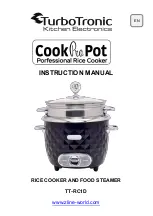
WHEN TO PERFORM A LEAK TEST:
•
After assembling your cooker and before lighting for the first time, even if purchased
fully assembled.
•
Every time the LP gas cylinder is refilled or if any of the gas components are replaced.
•
Any time your cooker has been moved.
•
At least once per year or if your cooker has not been used for more than 60 days.
GAS LEAK TESTING:
1. Create a mixture of 50% water and 50% liquid
dishwashing soap.
2. To turn on the fuel supply, turn the cylinder
valve knob one turn counterclockwise.
3. Apply the soap water mixture to the
following:
Supply tank (cylinder) weld
Connection nut to cylinder valve
Back side of connection nut to brass
nipple
Brass nipple connection into regulator
Regulator connection to gas supply
hose
Gas supply hose connection to
burner assembly
The full length of gas supply hose
Cylinder valve to cylinder
4. Check each place listed (A-H) for growing
bubbles which indicates a leak.
5. Turn OFF gas supply at cylinder valve.
6. Turn ON control knob to release gas pressure
in hose.
7. Turn control knob to OFF position.
8. Tighten any leaking connections.
9. Repeat soapy water test until no leaks are detected. DO NOT use the cooker if leaks cannot be stopped.
Contact a qualified gas appliance repair service.
10. Turn OFF gas supply at cylinder valve until you are ready to use your cooker.
11. Wash off soapy residue with cold water and towel dry.
12. Wait 5 minutes to allow all gas to evacuate the area before lighting cooker.
NOTE
: The leak test must be performed in an area that has adequate lighting in order to see if
bubbles are developing.
DO NOT
use a flashlight to check for bubbles.
8
WARNING
IM
PO
RT
AN
T S
AFE
GU
AR
D
• DO NOT REMOVE THIS TAG •
TURN GAS ON AND OFF
USINGVALVE ON L.P. GAS
TANK. USE THIS RED
CONTROL VALVE FOR
FLAME ADJUSTMENT ONLY.
A
B
C
D
E
F
G
H
A
B
C
D
E
F
G
H
Watch For Bubbles





































